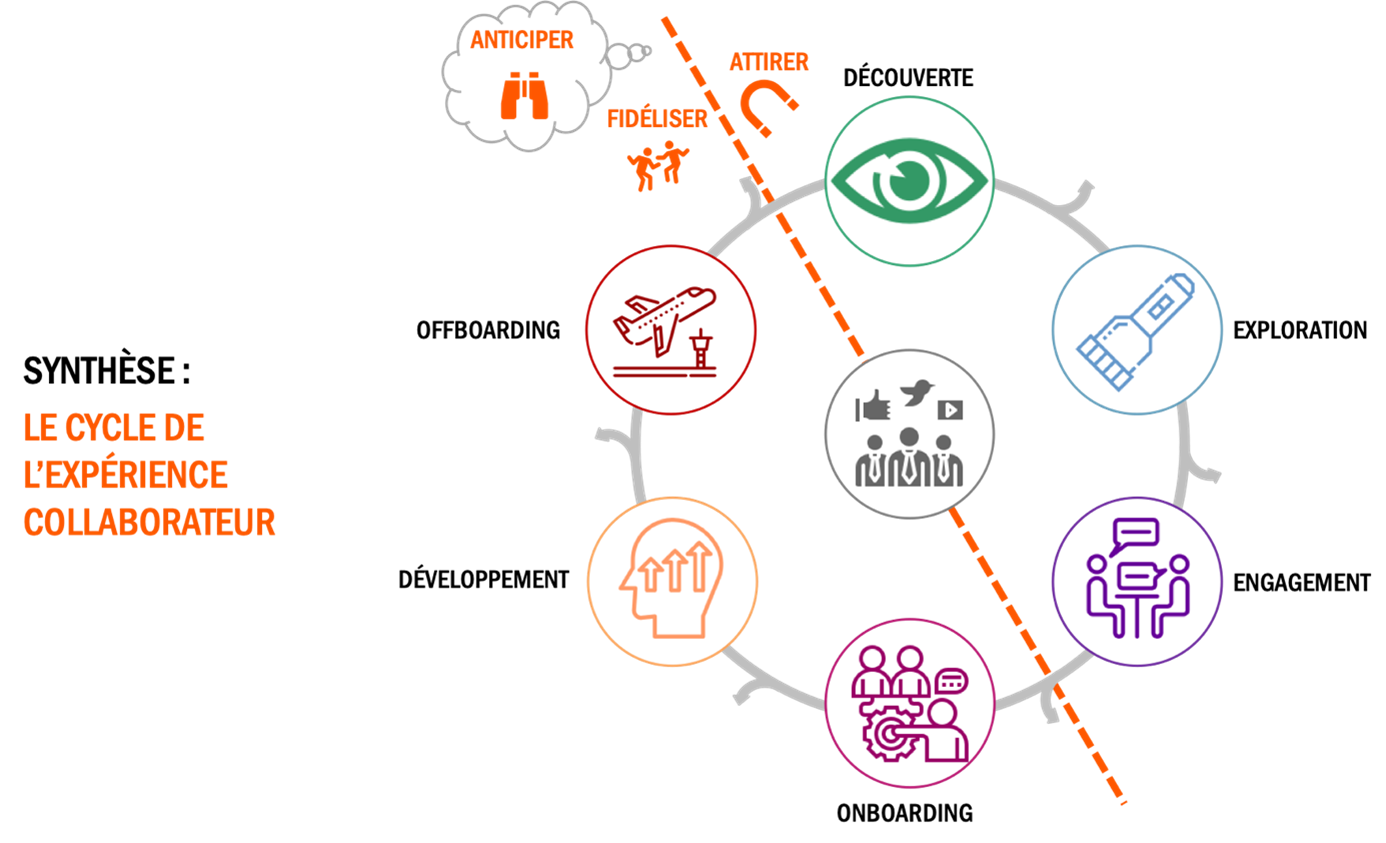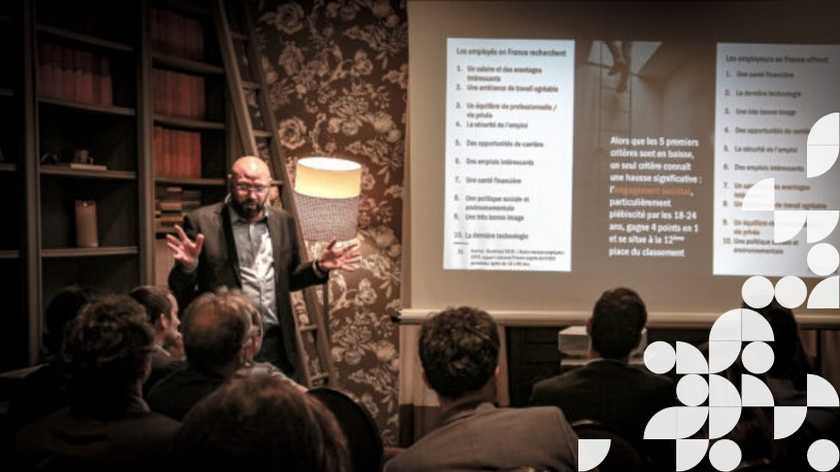Recruiting and retaining talent has never been more complex, just as it has never been easier to change companies. In late 2019, CIOs from various sectors braved transportation strikes to come together and discuss this fascinating topic presented by Ludovic Milléquant, Director of HR Offer at Aneo.
The Observations
Over the past two years, APEC (Association pour l'emploi des cadres) presents record numbers in terms of mobility, never reached since 1974. More broadly, "traditional" companies struggle to attract and retain talent, especially in IT profiles. How can this be explained?
Millennials, born in the late 1980s and now representing 35% of the active population in France, no longer seek just a job providing stability and career prospects: the search for meaning, authenticity, work environment, and balance between personal and professional life are also at the heart of their concerns, although salary remains the number one retention factor. Cases where employees refuse a promotion to maintain their work-life balance are becoming more and more common.
Moreover, many now choose to become independent contractors, a population that now represents 3.1 million workers in France, especially in IT (90% of freelancers). An alternative that allows some to work 4 days a week or 6 months a year, to have the opportunity to dedicate time to their personal projects. Working 12 hours a day no longer appeals to young people, and it sometimes yields less profitability than their status as an independent contractor.
It is also the desire to participate in more innovative projects that drives them to apply to GAFA or startups rather than to large companies in the banking/insurance sector: these young people building their CVs no longer enter a company to stay there, they primarily want to develop their personal branding. They now expect the company to commit to them, rather than the other way around.
Another observation: millennials are no longer attracted to the role of manager. Therefore, how to retain and develop these talents with an expert profile? How to show them that they can have a career without necessarily becoming managers? How to make them adaptable to mobility, and quickly? The challenge of developing expertise pathways becomes paramount, as well as helping managers develop a discourse emphasizing the possibility of renewal, learning, challenge, team and branch changes, and being valued: at Google, for example, 40% of employees are directed towards expertise pathways and give conferences worldwide to inspire and share knowledge internally.
Furthermore, internal processes do not always make things easier!
Today, every company dreams of the fairy tale where CIOs, HR, and Procurement sit down together to find a miraculous solution to this issue. However, HR, due to lack of information, still struggles to take into account the specificities of the IT department and to anticipate recruitment projects and trends in skills needs for the next 3 to 5 years (or at least the coming year).
This prospective approach can be even more complex in projects involving emerging technologies and thus new types of profiles to recruit.
The sometimes very heavy recruitment processes (5 to 6 stages per candidate) lead to losing good profiles along the way, while the trend is now towards shorter cycles.
Employee retention starts from their integration: how to make the employee feel comfortable in their new environment, and quickly? Today, 42% of departures occur in the year following arrival. To attract candidates, many companies have now chosen to be transparent in their communication about their integration process.
Finally, CIOs and HR face a major problem of disengagement with internal profiles who have been in the same position for 5, 10, 20 years, or even more.
How to renew them and preserve the value generation? How to develop them, get them out of their comfort zone, update them, and motivate them again?
The challenge here is to open these employees to the market, show them that their activity can be done differently, and rework their internal employability by making them proud of what they have learned.
Offering them a training program can be a solution perceived as a reward. Similarly, integrating them into an expertise program can rejuvenate them, develop them, accelerate their careers, and bring them recognition from their peers. Of course, the risk of departures at the end of the program is always present, but isn't the gain worth it?
The Employee Experience Cycle
To attract and retain employees, it is important to improve their experience throughout their evolution in the company.

Ways to Improve the Employee Experience
[Anticipate] Strategic Workforce Planning
Anticipate the evolution of skills needs in line with the company's strategic plan, the needs for each job profile in 3 - 5 years, and market evolution. This is a real alignment issue between business, finance, and HR, which will enable HR to implement sourcing and skills development solutions to ensure the execution of the PMT (Project Management Team). If the exercise seems delicate, or even akin to a crystal ball, one can be reassured by comparing it to the business plan of a start-up, which will be amended at least every year, if not every quarter (Workforce Planning).
[Anticipate] Map Reference Jobs
Define the required skills and their mastery level for each reference job. A reference job will serve as a basis for several individual jobs that will have a common skillset (80%). This base will facilitate mobility in an objective and facilitating way for both employees and HR and managers. It is therefore important to communicate them transparently so that everyone can understand them, identify their areas of improvement, and anticipate their career projections.
[Fidelize] Develop Expertise Paths
On the one hand, fewer and fewer employees - millennials leading the way - aspire to become managers. On the other hand, organizations are reducing the number of managers to increase span of control (number of employees supervised by a manager), to reduce structural costs, and to legitimize the role of managers... the self-management manager is over! However, for decades, the only structured way to progress in the company was the managerial path. It is therefore time to develop expertise pathways, parallel to managerial pathways, to make employees grow by giving them career prospects. This is notably what Société Générale did within its IT department. It also allows capitalizing on the knowledge of talents, making them shine and thus contributing to increasing the performance of their peers.
[Fidelize] Implement Total Talent Management
Work with Procurement and HR to implement comprehensive sourcing, in order to recruit a skill, whether carried by an internal or an external, rather than based on the type of contract. This seems obvious on paper, but in the vast majority of companies, decisions are made on the type of contract first, especially in France, where the permanent contract (CDI) remains the norm. The main reason for this is the economic pressure that a CDI represents, while in recent years, we have seen a relaxation of the legal framework for ending a CDI. It is therefore possible to move closer to Anglo-Saxon practices, which have been able to develop this model thanks to the simplicity of their social framework. This will also be possible as soon as business, HR, and Procurement have aligned their objectives with the triptych of quality-cost-delay of skills.
[Attract] Define and Highlight the Uniqueness of the Employer Brand
A "good" employer brand is based on the authenticity of the company: its history, its culture, its purpose, and its practices. By working on how these values and principles are embodied in the daily life of the teams, and by ensuring that they are reflected externally - including on public platforms such as Glassdoor - an authenticity message is delivered to candidates, which corresponds to their expectations, and allows the company to stand out from its competitors... other than by its turnover or international presence. It is also the best way to stay true to oneself rather than trying to be someone else... because we sometimes forget it, but the company, as a legal entity, is indeed a person, and the principles that apply to physical persons can also apply to legal persons!
[Attract] Think Outside the Box to Stand Out
Attracting candidates requires real HR marketing. Competition has never been so diverse: reassuring large groups, inspiring GAFA, innovative SMEs, promising startups... once you have defined your uniqueness, you must distinguish yourself by the originality of your dialogue with candidates. Innovative recruitment methods such as Google's Easter Egg Challenge, which consists of cracking the code of the Google homepage to have the right to a recruitment interview, are perceived as innovative and attractive by talents, more or less young. And frugality is often the best way to find original solutions!
[Measure] Evaluate the Performance of Each Initiative
You use test-and-learn principles: that's good! You have opted for frugality: that's even better! It now remains to measure whether these initiatives bear fruit and bring you the quality and quantity of candidates needed. The most important thing is to define the right performance indicators and the modalities and frequency of measurement. For example, why not ask your interns, apprentices, and young hires what would make them want to apply or stay with you? Not to mention that too many KPIs kill the KPI!
The key to these actions mainly lies in the collective intelligence that the company's stakeholders will mobilize, from strategy to execution.




